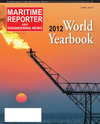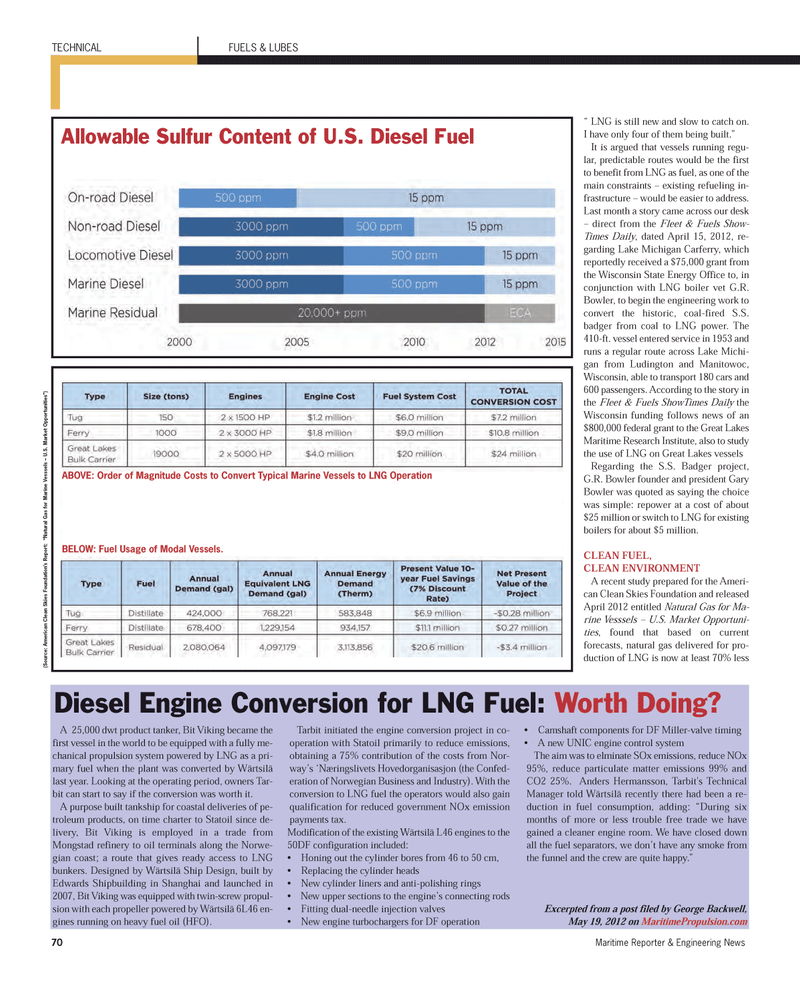
Page 70: of Maritime Reporter Magazine (June 2012)
Annual World Yearbook
Read this page in Pdf, Flash or Html5 edition of June 2012 Maritime Reporter Magazine
? LNG is still new and slow to catch on. I have only four of them being built.? It is argued that vessels running regu- lar, predictable routes would be the first to benefit from LNG as fuel, as one of the main constraints ? existing refueling in- frastructure ? would be easier to address. Last month a story came across our desk? direct from the Fleet & Fuels Show-Times Daily , dated April 15, 2012, re- garding Lake Michigan Carferry, which reportedly received a $75,000 grant from the Wisconsin State Energy Office to, in conjunction with LNG boiler vet G.R. Bowler, to begin the engineering work to convert the historic, coal-fired S.S. badger from coal to LNG power. The 410-ft. vessel entered service in 1953 and runs a regular route across Lake Michi- gan from Ludington and Manitowoc, Wisconsin, able to transport 180 cars and 600 passengers. According to the story in the Fleet & Fuels ShowTimes Daily theWisconsin funding follows news of an $800,000 federal grant to the Great Lakes Maritime Research Institute, also to studythe use of LNG on Great Lakes vessels Regarding the S.S. Badger project, G.R. Bowler founder and president Gary Bowler was quoted as saying the choice was simple: repower at a cost of about $25 million or switch to LNG for existing boilers for about $5 million.CLEAN FUEL, CLEAN ENVIRONMENTA recent study prepared for the Ameri- can Clean Skies Foundation and releasedApril 2012 entitled Natural Gas for Ma- rine Vesssels ? U.S. Market Opportuni- ties, found that based on currentforecasts, natural gas delivered for pro- duction of LNG is now at least 70% less 70Maritime Reporter & Engineering News TECHNICALFUELS & LUBESABOVE: Order of Magnitude Costs to Convert Typical Marine Vessels to LNG Operation BELOW: Fuel Usage of Modal Vessels. (Source: American Clean Skies Foundation?s Report: ?Natural Gas for Marine Vesssels ? U.S. Market Opportunities?) Allowable Sulfur Content of U.S. Diesel FuelA 25,000 dwt product tanker, Bit Viking became the first vessel in the world to be equipped with a fully me- chanical propulsion system powered by LNG as a pri- mary fuel when the plant was converted by Wärtsilä last year. Looking at the operating period, owners Tar- bit can start to say if the conversion was worth it. A purpose built tankship for coastal deliveries of pe- troleum products, on time charter to Statoil since de-livery, Bit Viking is employed in a trade from Mongstad refinery to oil terminals along the Norwe- gian coast; a route that gives ready access to LNG bunkers. Designed by Wärtsilä Ship Design, built by Edwards Shipbuilding in Shanghai and launched in 2007, Bit Viking was equipped with twin-screw propul- sion with each propeller powered by Wärtsilä 6L46 en- gines running on heavy fuel oil (HFO). Tarbit initiated the engine conversion project in co- operation with Statoil primarily to reduce emissions,obtaining a 75% contribution of the costs from Nor- way?s ?Næringslivets Hovedorganisasjon (the Confed- eration of Norwegian Business and Industry). With the conversion to LNG fuel the operators would also gain qualification for reduced government NOx emission payments tax.Modification of the existing Wärtsilä L46 engines to the 50DF configuration included: Honing out the cylinder bores from 46 to 50 cm, Replacing the cylinder heads New cylinder liners and anti-polishing rings New upper sections to the engine?s connecting rods Fitting dual-needle injection valves New engine turbochargers for DF operation Camshaft components for DF Miller-valve timing A new UNIC engine control system The aim was to elminate SOx emissions, reduce NOx 95%, reduce particulate matter emissions 99% andCO2 25%. Anders Hermansson, Tarbit's Technical Manager told Wärtsilä recently there had been a re- duction in fuel consumption, adding: ?During sixmonths of more or less trouble free trade we have gained a cleaner engine room. We have closed down all the fuel separators, we don?t have any smoke from the funnel and the crew are quite happy.? Excerpted from a post filed by George Backwell, May 19, 2012 on MaritimePropulsion.comDiesel Engine Conversion for LNG Fuel: Worth Doing? MR June12 # 9 (65-73):MR Template 6/12/2012 3:27 PM Page 70

 69
69

 71
71
